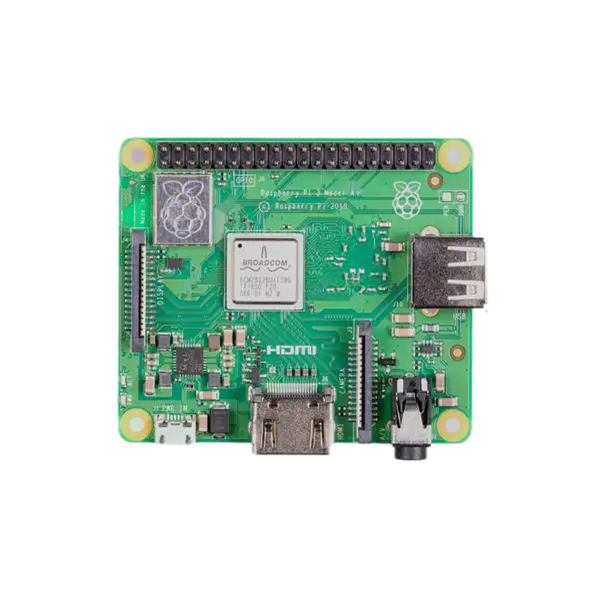Raspberry Pi 3 Model A+ is an updated version of the Raspberry Pi 1 Model A+, offering a more compact and less expensive option within the Raspberry Pi 3 series. Here are some key details:

- Dimensions: It maintains the small form factor of the Raspberry Pi 1 Model A+, measuring 65mm x 56.5mm x 10mm, making it one of the smallest models in the Raspberry Pi lineup.
- Processor: The Model A+ features the same Broadcom BCM2837B0 64-bit ARMv8 processor as the Raspberry Pi 3 Model B+, clocked at 1.4GHz. This represents a significant performance increase over the Raspberry Pi 1 A+.
- Memory: It comes with 512MB of LPDDR2 SDRAM, which is less than the 1GB in the Model B+ but still adequate for many applications.
- Wireless Connectivity:
- Onboard 802.11n Wireless LAN (WLAN) with a built-in antenna, providing easy internet access.
- Bluetooth 4.2 Low Energy (BLE), allowing for wireless communication with peripherals.
- I/O Interfaces:
- 40 GPIO pins for hardware interfacing and expansion, the same as the Raspberry Pi 3 B+.
- One USB 2.0 port, a reduction from the four in the Model B+.
- An HDMI port capable of 1080p video output.
- A microSD card slot for storage.
- A CSI camera connector.
- A micro USB power port, supporting up to 2.5A for improved power management.
- An audio jack for sound output.
- Storage: Uses a microSD card for the operating system and data storage.
- Power: Requires a 5V/2.5A power supply, reflecting its higher power requirements due to the enhanced processor and wireless capabilities.
- Price: The Raspberry Pi 3 Model A+ was designed to be more affordable than the Model B+, offering a balance between cost and performance.
- Usage:
- Education: Its small size, affordability, and wireless capabilities make it suitable for teaching basic computing, networking, and IoT concepts.
- DIY Projects: Ideal for small, battery-powered projects, low-cost IoT devices, portable computing, and learning about electronics and programming.
- Embedded Systems: Due to its low power consumption and compact size, it’s perfect for embedded applications where space and energy efficiency are crucial.
- Development: Useful for initial prototyping or when developing small, standalone applications where wireless connectivity is needed.
Advantages
- Performance: The quad-core 64-bit processor at 1.4GHz provides a significant performance boost over previous A+ models.
- Wireless: Built-in Wi-Fi and Bluetooth simplify setup and connectivity for various projects.
- Compact Size: Its small footprint allows for easy integration into projects where space is limited.
- Low Power Consumption: Designed to be energy-efficient, making it suitable for battery-powered applications.
Limitations
- Memory: With only 512MB of RAM, it’s less capable of handling memory-intensive tasks compared to higher models.
- Single USB Port: The limitation to one USB port might restrict the number of peripherals you can connect directly to the board.
- Heat: Similar to other Raspberry Pi 3 models, the processor can generate heat, which might require cooling for intensive use.
The Raspberry Pi 3 Model A+ was introduced to provide a more powerful and feature-rich alternative to the original Model A+ while maintaining its compact size and affordability. Its enhancements in processing power and wireless connectivity make it an excellent choice for a wide range of educational, DIY, and embedded computing projects where size, cost, and power efficiency are key considerations.
Software & OS
Software installation
Raspberry Pi OS is the recommended operating system for normal use on a Raspberry Pi.
Raspberry Pi Imager is the quick and easy way to install Raspberry Pi OS and other operating systems to a microSD card, ready to use with your Raspberry Pi.
Find help with installing Raspberry Pi OS on your Pi in our online Getting started guide.
You can browse basic examples to help you get started with some of the software available in Raspberry Pi OS, find more detail about Raspberry Pi OS, or read information on fundamental Linux usage and commands for navigating the Raspberry Pi and managing its file system and users.
Documents
- Raspberry Pi 3 Model A+ product brief
- Raspberry Pi 3 Model A+ mechanical drawing
- Raspberry Pi 3 Model A+ schematic diagrams
- More detailed information on Raspberry Pi hardware
Compliance
The Raspberry Pi 3 Model A+ has undergone extensive compliance testing, and meets the following European standards:
- Electromagnetic Compatibility Directive (EMC) 2014/30/EU
- Restriction of Hazardous Substances (RoHS) Directive 2011/65/EU
View and download global compliance certificates for Raspberry Pi products.
The dual-band wireless LAN comes with modular compliance certification. This allows the board to be designed into end product with significantly reduced wireless LAN compliance testing, improving both cost and time to market.
The Adopted Trademarks HDMI®, HDMI High-Definition Multimedia Interface, and the HDMI Logo are trademarks or registered trademarks of HDMI Licensing Administrator, Inc. in the United States and other countries.
